Journeying Through Time on Lake Windermere
by Pearl Harris
Windermere is England's largest lake, situated in the northwest
county of Cumbria. It is, strictly speaking, incorrect to refer
to this lovely stretch of water as "Lake Windermere," "mere"
being another word for "lake." The name, "Windermere," derives
from the old Norse "Onundar Myrr." We need to travel back in
time long before the Norsemen, however, to trace the origins of
human habitation on these shores. The first evidence we have of
man living here is that of Neolithic man.
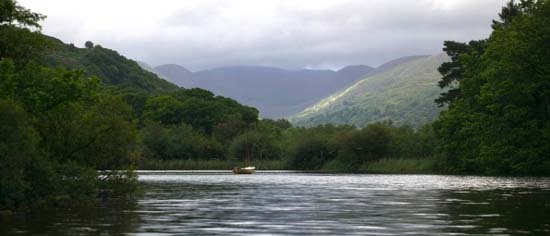
The remains of an axe factory dating back to 4000 BC were
discovered near Langdale Pikes. It is clear that the manufacture
of stone tools (used mainly for tree-felling and killing of
animals) was a thriving industry, as tools from Langdale have
been discovered at numerous other sites around Britain. By 2000
BC, the Windermere countryside had developed into a fertile
agricultural region, ground being cleared and trees felled for
this purpose. Copper, lead and iron ore were mined and the
pottery industry gained importance.
Evidence of Roman occupation at Windermere dates back to 1 AD, as
evidenced by the extensive remains of the fort at Galava. Galava
fort is thought to have been constructed in 90 AD and later
extended by Hadrian. It was linked by road to the important port
of Ravenglass, as well as to Hadrian's Wall, the boundary of the
Roman Empire.
Between 300 and 400 AD, when the Roman occupation of Britain
ended, the region came under the control of Furness Abbey.
Farming continued to prosper, with the introduction of the hardy
mountain sheep, while small foundries were built to smelt the
iron ore. By 1000 AD, the area was inhabited by a thriving
farming population who built the dry stone walls, such a
distinctive feature today, as boundaries to control grazing. The
most significant event of this period was the Viking invasion.
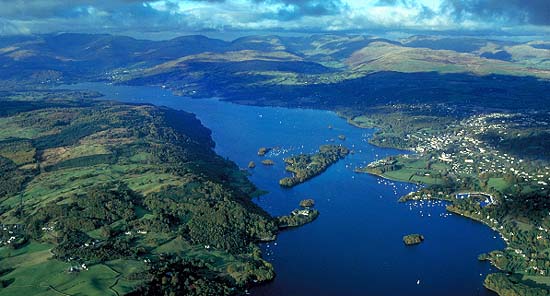
Ambleside, at the northern tip of Windermere, is said to owe
its name to a Viking landowner by the name of Hamel. Ambleside
gradually developed into an industrial hub. The 'old' town on
the hill around St. Anne's Church was built after the departure
of the Romans, with expansion in the 6th and 7th centuries into
what is now the town center. Ambleside's farming population
continued to be self-sufficient, while copper and lead mining and
the quarrying of slate brought in extra revenue. The gray slate
buildings today remain a striking feature of the Lakeland.
During the reign of Henry VIII, monasteries were closed down and
farms divided into smaller lots. A successful market center was
developed at Ambleside, with a bustling trade in corn, cloth,
paper and bark.
The Industrial Revolution heralded a new era in which
Windermere's water power was utilized for the important industry
of bobbin production, so essential for the "dark Satanic mills"
of the North. Wealthy mill owners and ship owners of the North
began to build luxurious holiday mansions on the shores of
Windermere. Many of these stately homes stand to this day in an
excellent state of preservation, most having been converted into
hotels or holiday apartments.
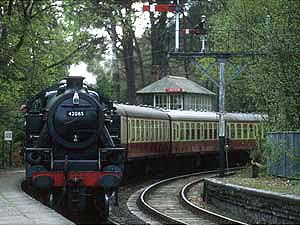 William Wordsworth (1770 -
1850), one of the first Romantic writers to extol the beauties of
the English Lakeland, helped to popularize it as a tourist
destination in lines such as: William Wordsworth (1770 -
1850), one of the first Romantic writers to extol the beauties of
the English Lakeland, helped to popularize it as a tourist
destination in lines such as:
There was a boy: ye knew him well, ye cliffs
And islands of *Winander! -- many a time
At evening, when the earliest stars began
To move along the edges of the hills,
Rising or setting, would he stand alone
Beneath the trees or by the glimmering lake...
*the old name for "Windermere"
In 1847 the railway first reached what is now the town of
Windermere, at that time just a tiny village known as Birthwaite. The railway facilitated access to the Lakeland for the ordinary
working man, and not only for the idle rich. By 1850, Ambleside
had become a popular resort and tourism an important industry.
The Victorian shops and houses to be seen in Ambleside today, as
well as St. Mary's Parish Church were all built in this era of
increasing tourism and prosperity.
Not everyone, however, waxed lyrical about the Lakeland!
Ambleside was most unflatteringly described by Charles Dickens as
follows:
Round Ambleside you will indeed find hills and
waterfalls -- decked with greasy sandwich papers and porter
bottles, and the hills echo with the whistles of the Windermere
steamersΙ brass bands play under your hotel windows,
char-a-bancs, wagonettes and breaks of all colours rattle about
with cargoes of tourists who have been 'doing' some favorite
round. Touts pester you in the streets and in the hotel coffee
room you overhear a gentleman ask angrily, "Why don't they build
an 'ut on 'elvellyn * -- they've got one on Snowdon."
*Helvellyn -- one of the peaks above Ambleside
Dickens was also particularly rude about the excessive drinking
habits of the locals. A 21st century local on an Ambleside
webpage comments that "nothing has changed since Dickens' time,
except that there are more locals now. One theory is that this
drinking is stress-related, brought on by the constant
territorial invasion by tourists!"
Although prosperity rapidly increased as a result of the tourist
influx, Ambleside was slow to improve its standards of living.
The feminist journalist, Harriet Martineau, who made her home in
Ambleside, reported on the poor health, sanitation and housing
conditions of the locals.
In 1845, the first paddle-steamer, the Lady of the Lake,
was launched at Windermere by The Windermere Steam Yacht
Company. She was soon joined by the Lord of the lsles.
The Windermere Iron Steamboat Company, a second company which
linked up with the railway, was also established. Their iron
paddle-steamer, the Firefly, assembled by a firm of
Liverpudlian shipbuilders on a specially constructed site near
Ambleside, was launched in 1849.
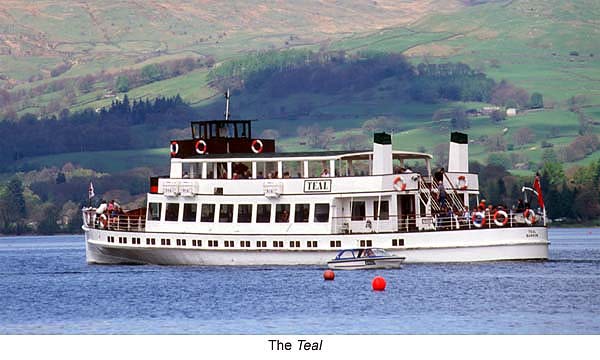
These two rival companies vied for business for a decade before
finally amalgamating in 1858 under the title of The Windermere
United Steam Yacht Company. In 1867, the Furness Railway
constructed a line from Ulverston to Newby Bridge and later to
Lakeside and, in 1872, bought out the United Steam Yacht Company.
The Furness Company acquired the Swan, a specially
designed lake-going vessel, which plied the waters of Windermere
for many years, to be superseded by the present-day Swan.
The Swan was joined by two sister ships, the Cygnet
and the Teal.
The Furness Railway transported many thousands of visitors to
Windermere, the golden era of rail travel ending, however, with
the advent of the motor car and the outbreak of World War I.
Today, surprisingly, there has been a great revival of interest
in steam train travel. Enthusiasts have preserved approximately
three miles of track from Haverthwaite to Lakeside, enabling
travelers to experience a small part of British transport history
when they "take the train to the lake."
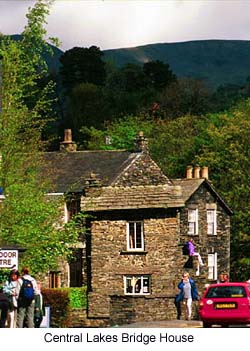 Despite incredible expansion due to tourism, Ambleside
manages to retain its ancient charm. This is a historic town
worth exploring at leisure, with architectural treasures around
every corner. The Old Water Mill in the center of town is an
exact replica of one that used to serve the bark mill. The Bridge
House on Stock Ghyll was built right on the small stone
bridge spanning a gurgling stream! Legend has it that the owner
did this to avoid paying rates, the stream being public property!
Whatever the truth of the matter, Bridge House is a
much-photographed tourist attraction today. Despite incredible expansion due to tourism, Ambleside
manages to retain its ancient charm. This is a historic town
worth exploring at leisure, with architectural treasures around
every corner. The Old Water Mill in the center of town is an
exact replica of one that used to serve the bark mill. The Bridge
House on Stock Ghyll was built right on the small stone
bridge spanning a gurgling stream! Legend has it that the owner
did this to avoid paying rates, the stream being public property!
Whatever the truth of the matter, Bridge House is a
much-photographed tourist attraction today.
St. Mary's Church, built in the 1850s in the Early Gothic style,
is constructed of sandstone with a distinctive spire and contains
beautiful stained glass windows. The choir stalls are carved with
figures of fourteen Saints. St. Mary's is one of only five
Cumbrian churches that still continue the annual Rushbearing
Ceremony in July. This ceremony originates from the time when
Church floors were made of ground, covered in rushes. In the
past, it was the custom to bury corpses inside the Church, as
well as in the churchyard. On special occasions, villagers
brought sweet smelling rushes, with which they covered the Church
floors, thereby freshening the air and insulating worshippers
from the cold. Rushbearing ceased in the 19th century, when
Church floors became paved. The children of Ambleside today
carry a cross of rushes or flowers to the Church, in a procession
led by a band and clergy.
Ambleside's Armitt Museum houses an astonishing collection
of archaeological finds, works of art, archives, books and
historic local photographs. Of particular interest are the superb
collections of Neolithic, Bronze and Roman artifacts found in the
area. Another highlight of the Museum is the collection of over
400 water colors by Beatrix Potter. The Armitt Museum archives
include letters, folk songs, legal documents and manuscripts.
These relate to famous academics, writers and noteworthy
characters of the district, such as Harriet Martineau and John
Ruskin.
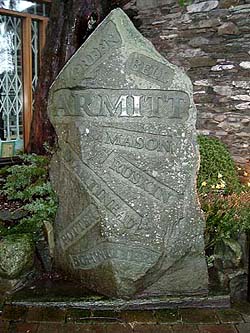 Over 10,000 books of
historic significance to the Lake District are on display. Among
these titles are huge collections of early guide books, local
history books and books by local authors such as Beatrix Potter,
Arthur Ransome and Norman Nicholson. Over 10,000 books of
historic significance to the Lake District are on display. Among
these titles are huge collections of early guide books, local
history books and books by local authors such as Beatrix Potter,
Arthur Ransome and Norman Nicholson.
Undoubtedly the ideal way of savoring all the historic and scenic
wonders of Windermere is to take to the water. Steamboats have
departed from Waterhead pier, a short distance from
Ambleside, since 1845 when the first steamer company started
operating here. Sailing from Waterhead, you pass close to the
remains of Galava Fort on the western shore. Next, historic Wray
Castle comes into view. Built in the 19th century as a residence
for Dr. James Dawson of Liverpool, Wray Castle is now owned by
the National Trust and used as a training college.
Cruising through one of the deepest parts of the lake, you may
see the char fishing boats near Belle Grange Bay. On the shore
of Belle Grange Bay is the western base of the old Windermere
Ferry, which crossed the lake at this spot for centuries.
Three-quarter mile-long Belle Isle (formerly known as
Wynandermere Holme) is a famous landmark. The Round House on
Belle Isle was built at a cost of £5000 in 1774 and
remained in the Curwen family until recently. Wordsworth
referred to the Round House as a "pepper pot." After a severe
fire in 1996, extensive renovations have succeeded in restoring
the Round House to its former glory.
Hilltop, once owned by Beatrix Potter, is situated at Sawrey.
Other stately homes seen from the boat are Silverholme, a country
mansion now converted into flats, Lakeside Hotel, once a coaching
inn, and Graythwaite Estate.
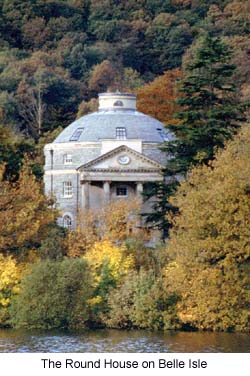 Bowness, one of the oldest recorded settlements
on the shores of Windermere, makes a pleasant port-of-call in any
cruise of the lake, situated as it is midway between Ambleside
and Lakeside. One of the earliest references to Bowness dates
back to 1190, when it was known as "Bulenas," meaning "Bull
Headland." Bowness, one of the oldest recorded settlements
on the shores of Windermere, makes a pleasant port-of-call in any
cruise of the lake, situated as it is midway between Ambleside
and Lakeside. One of the earliest references to Bowness dates
back to 1190, when it was known as "Bulenas," meaning "Bull
Headland."
Apart from an isolated incident in the Civil War when a Roundhead
party from Kendal unsuccessfully besieged the Philipsons' estate
on Long Holme (at which time the Church organ was 'cutt in
pieces') Bowness has remained a tranquil rural community. During
the past two centuries, tourism has overtaken the fishing
industry in Bowness as the Number One money-earner.
Legends interwoven with history abound along the dreamy shores of
Bowness. In 1864, Windermere froze and it was possible to walk
or skate across the lake from shore to shore. This remarkable
event happened again in the severe winters of 1894 and 1929, when
thousands came to experience the thrill of walking and skating on
the frozen lake. The lake froze over again in 1963 and 1982.
While breaking the world water speed record on Windermere in June
1930, Sir Henry Seagrave and his engineer were killed near
Bowness, watched by hundreds of spectators.
Another famous Windermere legend is that of Calgarth Estate,
former home of the wealthy Philipsons. The Master of Calgarth
envied the land of the neighboring Cooks, who stoically refused
to sell to him. As the story goes, Philipson subsequently had
his neighbors wrongfully arrested for theft, for which they were
tried and hanged.
The Philipsons thereafter acquired the Cook lands, but with it
inherited a curse. After being condemned to death, Dorothy Cook
raised her hand and ominously predicted that "Calgarth should
know no peace." After their hanging, the skulls of Dorothy and
her husband returned from their graves to haunt the Philipsons.
Bishop Watson, a later owner of Calgarth, had the skulls walled
up in a recess in the passage window where they have remained at
peace to this day!
On 19th October 1635, Windermere experienced its greatest
tragedy. After a wedding at Hawskhead, the wedding party set
out across the lake to continue its celebrations at the
bridegroom's home. The entire party of fifty was drowned,
though whether as a result of "a squall of wind or lack of
careful management" will never fully be established.
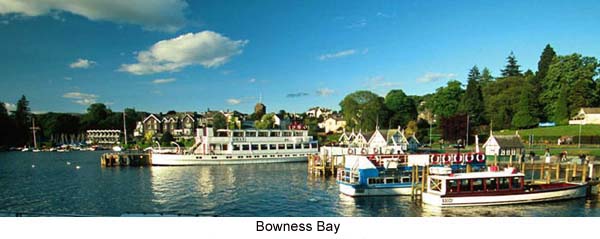
21st century Bowness Bay is a bustling port crammed with
steamers, ferries, pleasure launches, waterbuses, canoes,
windsurfers, rowing- and motor-boats of every description.
Fishing is enjoyed by locals and visitors. Numerous hotels have
sprung up, private homes have been built everywhere, resulting in
Bowness and adjacent Windermere today being the most populated
areas of the Lake District National Park.
From busy Bowness pier, take a short stroll back in time to the
old town itself. You may choose to dine in The Old England, one
of the Lakeland's most famous hotels, or pause for refreshments
in The Stag's Head, formerly a coaching inn.
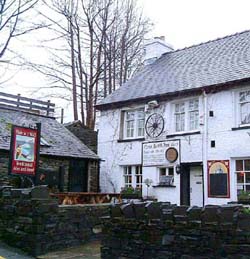 The Hole in't Wall
(right) is reputed to be the oldest tavern in town, deriving its
name from the small window through which ale was passed to
servants watching over their masters' horses outside in the yard.
It was the setting for Charles Dickens' narrative, "The Champion
Wrestler of All England." The Hole in't Wall
(right) is reputed to be the oldest tavern in town, deriving its
name from the small window through which ale was passed to
servants watching over their masters' horses outside in the yard.
It was the setting for Charles Dickens' narrative, "The Champion
Wrestler of All England."
St. Martin's Parish Church in Bowness, built in 1203, contains
magnificent stained glass windows of which the East Window,
bearing the coat of arms of the Washington family, is of special
interest to American visitors.
Windermere town itself, a mile uphill from Bowness, was
virtually non-existent before 1847 when the railway terminal was
built here. Many of the early Victorian guest houses still stand
today and Windermere remains the transport nerve center of the
lake.
Continuing southwards on your cruise, disembark at Lakeside
, the southern tip of Windermere. A few steps from the
steamboat jetty, the Aquarium of the Lakes, the United Kingdom's
leading freshwater aquarium, is a highlight not to be missed.
Here, you may observe the famous char, a fish unique to glacial
lakes. A fully grown char is about 10" in length and is
generally reputed to be a gastronomic delicacy. Speculation has
it that this fish was trapped in Windermere at the end of the
last Ice Age. Another theory is that it was introduced from the
Swiss Lakes by Roman legionnaires. Whatever the truth of its
origins, the char has remained a prized fish throughout history.
The Monks of Furness were given permission to catch it and a few
boats still retain this right to this day.
Daniel Defoe wrote of the char : "Winander Mere is famous for
producing the Char-fish.... It is a curious fish, and as a
Dainty, is potted and sent far and near by way of Present."
Before being potted, however, the char was more often used in
pies. Sir Daniel Fleming of Rydal spent large sums of money
sending Char Pies to friends in London. In 1666, a Char Pie
weighing no less than 28 kg. was sent to the Earl of Carlisle in
London. The Char Pie became a fashionable and much prized gift.
Its price rose from 3 shillings and 6 pence per dozen
(approximately 3¢ US each) to 9 shillings per dozen (
8¢ US each)!
As the fish became increasingly expensive, housewives and chefs
concentrated on potting it instead of baking it in pies. A report
in 1787 reads: .'.many pots are sent to different parts of the
Kingdom every year.'
The Aquarium of the Lakes also affords close encounters with
eels, pike, sharks, otters and a variety of other aquatic life
Over thirty informative displays recreate the journey of a
Lakeland river from the mountain top to Morecambe Bay.
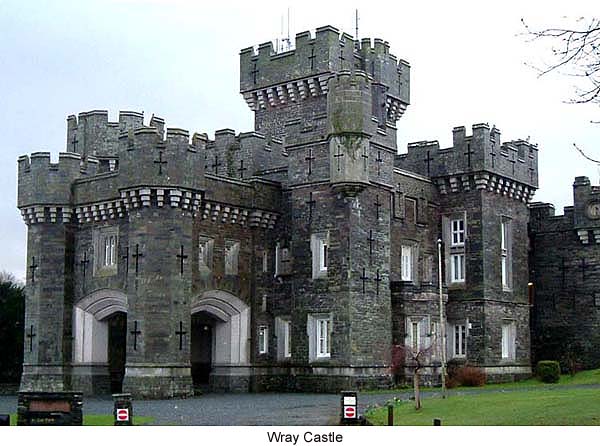
Lakeside is the traditional home of the Lake Steamers as well as
being the historic headquarters of the Windermere Iron Steamboat
Company, located in the elegant Victorian structure at the
water's edge. A covered colonnade runs the full length of this
building, supported on the original decorative cast-iron columns.
This building also serves as the terminal of the Lakeside and
Haverthwaite Railway.
On a visit to Windermere, it is a good idea to escape the
stresses of driving and parking, while helping to preserve the
environment by using Cumbria's extensive network of rail, bus and
boat services. Traveling by public transport is a relaxing --
and Eco-friendly --way of visiting the numerous attractions of
the Lake District.. Pre-planned itineraries for days out on foot,
bus, boat or bicycle are obtainable from any Lake District
Tourist Information Center.
Various economical Travel Passes are available. The "Freedom of
the Lake" pass allows unlimited sailing for 24 hours on all
scheduled services between Ambleside and Lakeside, with stop-offs
anywhere en route. Combined tickets may also be purchased, such
as the Combined Boat and Aquarium ticket, which includes entry to
the Aquarium of the Lakes at Lakeside; the Combined Boat and
Train ticket, which includes a trip on the steam railway; or the
Combined Boat and World of Beatrix Potter Attraction ticket,
which includes the cruise to Bowness and entrance to The World of
Beatrix Potter.
Whichever means of transport you choose to visit Windermere, you
will store up a trove of historic knowledge, memories, sights
and sounds to last a lifetime!
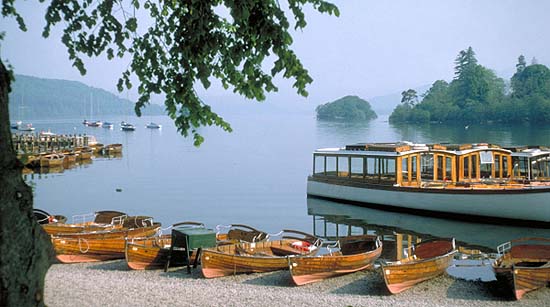
Related Articles:
- Wordsworth's Lakes, by Keith Kellett
- https://www.timetravel-britain.com/articles/country/wordsworth.shtml
More Information:
We regret that we no longer have the resources to maintain up-to-date links and/or hours and pricing details for the various sites and attractions listed on this website. For more information about the location(s) listed above, please use your favorite search engine or visit Wikipedia.
Pearl Harris, whose ancestors hail from Britain, was born in South Africa. In 2002, she emigrated to the Czech Republic with her husband, their dog and cat. Pearl resides permanently in the Czech Republic where she works as a freelance travel writer, English teacher and proof-reader. Her main passion is travel. Having traveled extensively in Africa, Europe,the USA and UK, she never intends to stop. Other interests are pets, photography, reading and writing. Pearl, a retired Diagnostic Radiographer, has a B.A. in English and Linguistics, post-graduate Diploma in Translation and TEFL qualification. Her only daughter, a professional photographer, lives in New Orleans.
Article and Bridge House photo © 2006 Harris
1st, 2nd and last photos courtesy of Britainonview.com; Armitt House, Hole i' the Wall and Wray Castle © Keith Kellett; "Teal," railway and Belle Isle courtesy of Windermere Lake Cruises; Bowness courtesy of Cultural and Tourism Services, South Lakeland District Council
|
